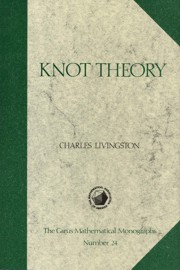Book contents
- Frontmatter
- ACKNOWLEDGEMENTS
- PREFACE
- Contents
- Chapter 1 A CENTURY OF KNOT THEORY
- Chapter 2 WHAT IS A KNOT?
- Chapter 3 COMBINATORIAL TECHNIQUES
- Chapter 4 GEOMETRIC TECHNIQUES
- Chapter 5 ALGEBRAIC TECHNIQUES
- Chapter 6 GEOMETRY, ALGEBRA, AND THE ALEXANDER POLYNOMIAL
- Chapter 7 NUMERICAL INVARIANTS
- Chapter 8 SYMMETRIES OF KNOTS
- Chapter 9 HIGH-DIMENSIONAL KNOT THEORY
- Chapter 10 NEW COMBINATORIAL TECHNIQUES
- Appendix 1 KNOT TABLE
- Appendix 2 ALEXANDER POLYNOMIALS
- REFERENCES
- INDEX
PREFACE
- Frontmatter
- ACKNOWLEDGEMENTS
- PREFACE
- Contents
- Chapter 1 A CENTURY OF KNOT THEORY
- Chapter 2 WHAT IS A KNOT?
- Chapter 3 COMBINATORIAL TECHNIQUES
- Chapter 4 GEOMETRIC TECHNIQUES
- Chapter 5 ALGEBRAIC TECHNIQUES
- Chapter 6 GEOMETRY, ALGEBRA, AND THE ALEXANDER POLYNOMIAL
- Chapter 7 NUMERICAL INVARIANTS
- Chapter 8 SYMMETRIES OF KNOTS
- Chapter 9 HIGH-DIMENSIONAL KNOT THEORY
- Chapter 10 NEW COMBINATORIAL TECHNIQUES
- Appendix 1 KNOT TABLE
- Appendix 2 ALEXANDER POLYNOMIALS
- REFERENCES
- INDEX
Summary
Knot theory is an unusual field. On the one hand, its subject matter is familiar to everyone; the most difficult questions concerning knots are easy to state and arise as naturally as any problems in mathematics. On the other hand, the subject seems quite different from those that usually fall into the realm of mathematics; even for trained mathematicians, it is often not clear how rigorous mathematical methods can be used to model the most basic questions concerning knots. This book describes some of the mathematical techniques of knot theory, and illustrates their application to a variety of problems.
The early chapters discuss how knotting can be given a formal mathematical description, present three of the basic methods of the theory, and then investigate the relationships among the methods. The exposition then moves to a study of properties of knots, including a detailed look at symmetries. Higher dimensional knotting is treated next. The book concludes with a survey of recent progress in combinatorial knot theory.
Mathematical prerequisites have been kept to a minimum. Basic linear algebra is used frequently and a familiarity with elementary group theory is called for occasionally. The exercises are an essential part of the exposition; many central ideas are developed there. More important, the exercises provide an opportunity to enjoy the experience of working in knot theory.
The goal is to present a cross-section of the many fascinating aspects of knot theory; topics have been chosen to demonstrate a diversity of techniques and their interplay, not to provide a complete survey.
- Type
- Chapter
- Information
- Knot Theory , pp. xi - xivPublisher: Mathematical Association of AmericaPrint publication year: 1993



